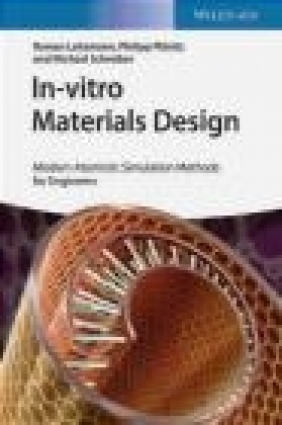In-Vitro Materials Design
Michael Schreiber, Philipp Planitz, Roman Leitsmann
In-Vitro Materials Design
Michael Schreiber, Philipp Planitz, Roman Leitsmann
- Producent: VCH
- Rok produkcji: 2015
- ISBN: 9783527334230
- Ilość stron: 234
- Oprawa: Miękka
Niedostępna
Opis: In-Vitro Materials Design - Michael Schreiber, Philipp Planitz, Roman Leitsmann
An overview of the latest computational materials science methods on an atomic scale. The authors present the physical and mathematical background in sufficient detail for this highly current and important topic, but without unnecessary complications. They focus on approaches with industrial relevance, covering real-life applications taken from concrete projects that range from tribology modeling to performance optimization of integrated circuits. Following an introduction to the fundamentals, the book describes the most relevant approaches, covering such classical simulation methods as simple and reactive force field methods, as well as highly accurate quantum-mechanical methods ranging from density-functional theory to Hartree-Fock and beyond. A review of the increasingly important multiscale approaches rounds off this section. The last section demonstrates and illustrates the capabilities of the methods previously described using recent real-life examples of industrial applications. As a result, readers gain a heightened user awareness, since the authors clearly state the conditions of applicability for the respective modeling methods so as to avoid fatal mistakes.Preface IX Part I Basic Physical and Mathematical Principles 1 1 Introduction 3 2 Newtonian Mechanics and Thermodynamics 5 2.1 Equation of Motion 5 2.2 Energy Conservation 7 2.3 Many Body Systems 10 2.4 Thermodynamics 11 3 Operators and Fourier Transformations 17 3.1 Complex Numbers 17 3.2 Operators 18 3.3 Fourier Transformation 20 4 Quantum Mechanical Concepts 25 4.1 Heuristic Derivation 25 4.2 Stationary Schrodinger Equation 27 4.3 Expectation Value and Uncertainty Principle 28 5 Chemical Properties and Quantum Theory 33 5.1 Atomic Model 33 5.2 Molecular OrbitalTheory 39 6 Crystal Symmetry and Bravais Lattice 47 6.1 Symmetry in Nature 47 6.2 Symmetry in Molecules 47 6.3 Symmetry in Crystals 49 6.4 Bloch Theorem and Band Structure 53 Part II ComputationalMethods 57 7 Introduction 59 8 Classical SimulationMethods 65 8.1 Molecular Mechanics 65 8.2 Simple Force-Field Approach 68 8.3 Reactive Force-Field Approach 71 9 Quantum Mechanical Simulation Methods 77 9.1 Born-Oppenheimer Approximation and Pseudopotentials 77 9.2 Hartree-Fock Method 80 9.3 Density Functional Theory 83 9.4 Meaning of the Single-Electron Energies within DFT and HF 85 9.5 Approximations for the Exchange-Correlation Functional EXC 88 9.5.1 Local Density Approximation 88 9.5.2 Generalized Gradient Approximation 89 9.5.3 Hybrid Functionals 90 9.6 Wave Function Representations 91 9.6.1 Real-Space Representation 91 9.6.2 PlaneWave Representation 92 9.6.3 Local Basis Sets 93 9.6.4 Combined Basis Sets 95 9.7 Concepts Beyond HF and DFT 96 9.7.1 Quasiparticle Shift and the GWApproximation 97 9.7.2 Scissors Shift 99 9.7.3 Excitonic Effects 100 9.7.4 TDDFT 100 9.7.5 Post-Hartree-Fock Methods 101 9.7.5.1 Configuration Interaction (CI) 102 9.7.5.2 Coupled Cluster (CC) 102 9.7.5.3 Moller-Plesset PerturbationTheory (MPn) 103 10 Multiscale Approaches 105 10.1 Coarse-Grained Approaches 105 10.2 QM/MM Approaches 108 11 Chemical Reactions 111 11.1 Transition State Theory 111 11.2 Nudged Elastic Band Method 114 Part III Industrial Applications 117 12 Introduction 119 13 Microelectronic CMOS Technology 121 13.1 Introduction 121 13.2 Work Function Tunability in High-k Gate Stacks 127 13.2.1 Concrete Problem and Goal 127 13.2.2 Simulation Approach 129 13.2.3 Modeling of the Bulk Materials 129 13.2.4 Construction of the HKMG Stack Model 132 13.2.5 Calculation of the Band Alignment 136 13.2.6 Simulation Results and Practical Impact 138 13.3 Influence of Defect States in High-k Gate Stacks 141 13.3.1 Concrete Problem and Goal 141 13.3.2 Simulation Approach and Model System 144 13.3.3 Calculation of the Charge Transition Level 145 13.3.4 Simulation Results and Practical Impact 146 13.4 Ultra-Low-k Materials in the Back-End-of-Line 149 13.4.1 Concrete Problem and Goal 149 13.4.2 Simulation Approach 151 13.4.3 The Silylation Process: Preliminary Considerations 153 13.4.4 Simulation Results and Practical Impact 155 14 Modeling of Chemical Processes 159 14.1 Introduction 159 14.2 GaN Crystal Growth 163 14.2.1 Concrete Problem and Goal 163 14.2.2 Simulation Approach 165 14.2.3 ReaxFF Parameter Training Scheme 166 14.2.4 Set of Training Structures: ab initio Modeling 168 14.2.5 Model System for the Growth Simulations 170 14.2.6 Results and Practical Impact 172 14.3 Intercalation of Ions into Cathode Materials 174 14.3.1 Concrete Problem and Goal 174 14.3.2 Simulation Approach 176 14.3.3 Calculation of the Cell Voltage 178 14.3.4 Obtained Structural Properties of LixV2O5 178 14.3.5 Results for the Cell Voltage 181 15 Properties of Nanostructured Materials 183 15.1 Introduction 183 15.2 Embedded PbTe Quantum Dots 187 15.2.1 Concrete Problem and Goal 187 15.2.2 Simulation Approach 188 15.2.3 Equilibrium Crystal Shape andWulff Construction 190 15.2.4 Modeling of the Embedded PbTe Quantum Dots 191 15.2.5 Obtained Structural Properties 194 15.2.6 Internal Electric Fields and the Quantum Confined Stark Effect 195 15.3 Nanomagnetism 199 15.3.1 Concrete Problem and Goal 199 15.3.2 Construction of the Silicon Quantum Dots 200 15.3.3 Ab initio Simulation Approach 203 15.3.4 Calculation of the Formation Energy 204 15.3.5 Resulting Stability Properties 205 15.3.6 Obtained Magnetic Properties 206 References 211 Index 221
Szczegóły: In-Vitro Materials Design - Michael Schreiber, Philipp Planitz, Roman Leitsmann
Tytuł: In-Vitro Materials Design
Autor: Michael Schreiber, Philipp Planitz, Roman Leitsmann
Producent: VCH
ISBN: 9783527334230
Rok produkcji: 2015
Ilość stron: 234
Oprawa: Miękka
Waga: 0.53 kg





























